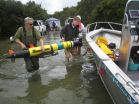New discoveries improve climate models
Underwater ridges impact ocean's flow of warm water
2011-02-04
(Press-News.org) New discoveries on how underwater ridges impact the ocean's circulation system will help improve climate projections.
An underwater ridge can trap the flow of cold, dense water at the bottom of the ocean. Without the ridge, deepwater can flow freely and speed up the ocean circulation pattern, which generally increases the flow of warm surface water.
Warm water on the ocean's surface makes the formation of sea ice difficult. With less ice present to reflect the sun, surface water will absorb more sunlight and continue to warm.
U.S. Geological Survey scientists looked back 3 million years, to the mid-Pliocene warm period, and studied the influence of the North Atlantic Ocean's Greenland-Scotland Ridge on surface water temperature.
"Sea-surface temperatures in the North Atlantic and Arctic Oceans were much warmer during the mid-Pliocene warm period than they are today, but climate models so far have been unable to fully understand and account for the cause of this large scale of warming," said USGS scientist Marci Robinson. "Our research suggests that a lower height of the Greenland-Scotland Ridge during this geologic age was a contributor to the increase of poleward heat transport."
"This is the first time the impact of a North Atlantic underwater ridge on the ocean circulation system was tested in a mid-Pliocene experiment," said Robinson. "Understanding this process allows for more accurate predictions of factors such as ocean temperature and ice volume changes.
Research was conducted on the mid-Pliocene because it is the most recent interval in the earth's history in which global temperatures reached and remained at levels similar to those projected for the 21st century by the Intergovernmental Panel on Climate Change. Therefore, it may be one of the closest analogs in helping to understand the earth's current and future conditions.
INFORMATION:
The article was published in the journal, Palaeogeography, Palaeoclimatology, Palaeoecology, and can be viewed at http://dx.doi.org/10.1016/j.palaeo.2011.01.004. Any journalists who are not registered with this journal and cannot view this article can contact us to have a copy emailed to them.
This research contributes to the scientific foundation needed to make sound planning decisions in response to changes in climate and land use. To learn more, visit www.usgs.gov/climate_landuse/.
The USGS led this research through the Pliocene Research, Interpretation and Synoptic Mapping group. The primary collaborators in this research are the University of Leeds, University of Bristol and the British Geological Survey. For more information about PRISM research, visit http://geology.er.usgs.gov/eespteam/prism/index.html.
END
ELSE PRESS RELEASES FROM THIS DATE:
2011-02-04
COLUMBIA, Mo. – Starbucks recently announced a new-sized 31-ounce drink, the "Trenta," which will be in stores this spring. The mega-sized coffee joins the ranks of other energy drinks that can pack plenty of caffeine and calories. Ellen Schuster, a University of Missouri nutrition expert, says that Americans should be wary of extra calories and sugar in the quest for bigger, bolder drinks.
"The sheer size of new coffee and energy drinks increases consumers' potential for unhealthy calorie and sugar consumption," said Schuster, state specialist for MU Extension and the ...
2011-02-04
RENO, Nev. – A team of University of Nevada, Reno and University of Nevada, Las Vegas researchers have devised a new model for how Nevada's gold deposits formed, which may help in exploration efforts for new gold deposits.
The deposits, known as Carlin-type gold deposits, are characterized by extremely fine-grained nanometer-sized particles of gold adhered to pyrite over large areas that can extend to great depths. More gold has been mined from Carlin-type deposits in Nevada in the last 50 years – more than $200 billion worth at today's gold prices – than was ever mined ...
2011-02-04
They were called the Eighth Wonder of the World. Until the late 19th century, New Zealand's Pink and White Terraces along Lake Rotomahana on the North Island, attracted tourists from around the world, interested in seeing the beautiful natural formations created by a large geothermal system. But the eruption of Mt. Tarawera on June 10, 1886, buried the terraces in sediment and caused the lake basin to enlarge, engulfing the land where the terraces stood. For more than a century, people have speculated whether any part of the Pink and White Terraces survived the eruption.
This ...
2011-02-04
Mom's touch and diet – Claire-Dominique Walker, PhD, director, Neuroscience Research Division, Douglas Institute.
The quality and quantity of maternal milk and maternal-infant contact impact the stress response of the adult offspring, according to recent research published in Developmental Psychobiology. "This manuscript reviews and highlights how critical factors early in life can shape the physiology and behaviour of adult offspring," says Claire-Dominique Walker, Douglas research scientist and study senior author. "For example, we have shown that, in rodent models, ...
2011-02-04
Homeless people who do not get enough to eat use hospitals and emergency rooms at very high rates, according to a new study. One in four respondents to a nationwide survey reported not getting enough to eat, a proportion six times higher than in the general population, and more than two thirds of those had recently gone without eating for a whole day. The report will appear in the Journal of General Internal Medicine and has been released online.
"The study is the first to highlight the association between food insufficiency and health care use in a national sample ...
2011-02-04
(WASHINGTON, February 3, 2011) – For blood cancer patients at high risk of relapse, hematopoietic stem cell transplantation (HSCT), the transplantation of blood-forming stem cells, is one of best options for treatment and a potential cure. Unfortunately, the most common complication of HSCT is graft-versus-host disease (GVHD), a serious and often deadly post-transplant complication that occurs when the newly transplanted donor cells recognize the recipient's own cells as foreign and react by attacking the cells in the patient's body. A study published today in Blood, the ...
2011-02-04
The Gerontological Society of America (GSA) — the nation's largest interdisciplinary organization devoted to the field of aging — commends the federal government's recent release of the "2010 Dietary Guidelines for Americans" and particularly applauds its inclusion of specific advice for older adults.
Because more than one-third of children and more than two-thirds of adults in the U.S. are overweight or obese, the 7th edition of "Dietary Guidelines for Americans," issued by the Department of Agriculture and the Department of Health and Human Services, places stronger ...
2011-02-04
BOULDER--The aggressive wolverine may not be powerful enough to survive climate change in the contiguous United States, new research concludes.
Wolverine habitat in the northwestern United States is likely to warm dramatically if society continues to emit large amounts of greenhouse gases, according to new computer model simulations carried out at the National Center for Atmospheric Research (NCAR). The study found that climate change is likely to imperil the wolverine in two ways: reducing or eliminating the springtime snow cover that wolverines rely on to protect and ...
2011-02-04
COLUMBIA, Mo. – Each year, 29,000 foster youths are released from care as they become adults. A University of Missouri foster care expert says these young people encounter tremendous challenges as they transition out of care. However, those who receive care benefits through age 21 have greatly improved outcomes. Clark Peters, assistant professor in the School of Social Work, says all states should consider extending benefits for foster youth.
"The transition between foster care and the real world leaves many 18-year-olds without a place to stay, money, a job or reliable ...
2011-02-04
When a laboratory rat learns how to reach for and grab a food pellet – a pretty complex and unnatural act for a rodent – the acquired knowledge significantly alters the structure of the specific brain cells involved, which sprout a whopping 22 percent more dendritic spines connecting them to other motor neurons.
The finding, published in the journal Proceedings of the National Academy of Sciences by Mark H. Tuszynski, MD, PhD, professor of neurosciences and colleagues at the University of California, San Diego School of Medicine, underscores the brain's remarkable ability ...
LAST 30 PRESS RELEASES:
[Press-News.org] New discoveries improve climate models
Underwater ridges impact ocean's flow of warm water




